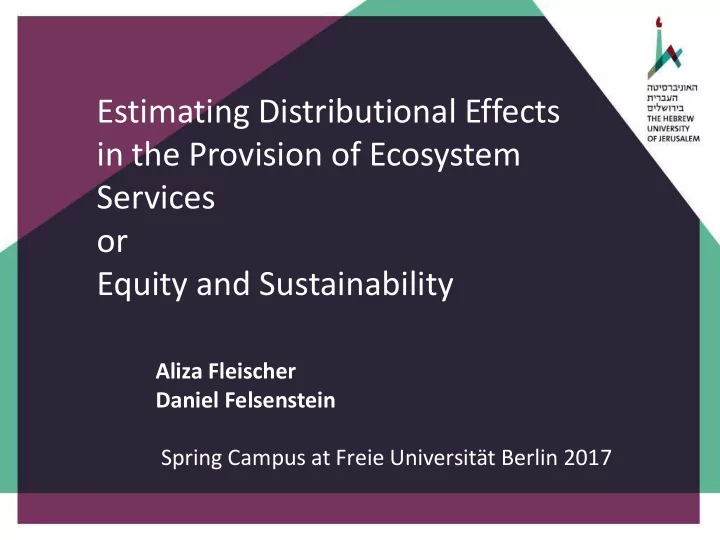

Estimating Distributional Effects in the Provision of Ecosystem Services or Equity and Sustainability Aliza Fleischer Daniel Felsenstein Spring Campus at Freie Universität Berlin 2017
Ecosystem Services (ES) • An ecosystem is a community of living organisms in conjunction with the nonliving components of their environment (air, water, soil), interacting as a system • Ecosystems in Israel: desert, marine, inland water, Mediterranean region, farmland, urban • ES: ‘the benefits people obtain from ecosystems’ (Millennium Ecosystem Assessment, MEA 2003) • Provisioning (food), regulating (water, climate) and cultural services (recreation)
Evaluation of Ecosystem Services (ES) • Most ES have no market value • In the economic discourse they are free of charge • Valuation methods have been developed in the literature • The main concern of world and country level assessments is to show the degradation of ES • Global human population and consumption patterns are well above what can be supported without impairing vital life-support systems • No reference to spatial and distributional effect of ES
Who benefits from ES? • public policy geared towards improving the welfare of low-income groups is expected to promote the progressive consumption of ecosystem services • This means that low-income groups are Rawles- compensated for social deprivation by receiving more ecosystem services than those received by high-income groups • If this is the case, then the distribution of the ecosystem services should favor the poor
Motivation • Global concern over change in ecosystems has prompted researchers and policymakers to consider the ‘value of ecosystem services’ in environmental management decisions • The Gap -> equity implications of the distribution of these services who benefits more?
The Aim • To develop a GIS based system for – identifying the main beneficiaries of ES in the population – simulating the distributional impacts of policy measure concerning ecosystems • We focus on recreation services: beaches, urban parks, national parks
Methodology Accurate population distribution with socio- economic attributes All data disaggregation is conducted on a national data set of census tracts downscaled to the level of the individual household and geo-referenced to a dwelling unit Measuring distance to sites with automatic GIS system Estimate consumer surplus (welfare) Simulate entrance fees scenarios
Age 65+ Household Male Female Person Child …Employment, Occupation, Age 18-64 car Ownership, Religion etc.… Adult
Measuring Distances – Network Analysis
Estimation of consumer surplus According to the sites • Coasts (marine) – Urban Parks (urban) – National Parks – (Mediterranean region) Socio-economic • attributes: Age – Gender – Education – Income – Distance •
Estimation of benefits 1. Estimation of consumer surplus is based on Fleischer and Tsur (2003) U mj = x mj β - ρ c mj + ξ mj ; m = 1,2,…, M ; j = 1,2,…., J m represents the utility an individual derives from visiting site j in ecosystem type m , where x mj is a vector of individual site characteristics, c ij is the travel cost , and J m the number of sites in ecosystem type m 2. Estimation of aggregate utility value 3. Probability of visiting each type of recreational site 4. Calculation of consumer surplus for each household 5. Disaggregation of utility by socio-economic groups
Annual average household benefits (NIS) by statistical area
Total annual benefits per statistical area (thousand NIS)
Annual average number of visits per household by statistical area
Distribution of ES benefits (2015 NIS) 800 719 700 600 482 500 439 NIS 400 329 317 312 295 290 300 244 217 200 100 0 1 2 3 4 5 Quantiles Income quantiles Housing value quantiles
Simulation: Entrance fee $5.5 to Tel Aviv Beaches and Hayarkon Park 500 439 450 413 400 344 350 317 312 298 295 295 290 300 275 274 262 253 246 NIS 234 250 200 150 100 50 0 1 2 3 4 5 Income quantiles before fee fee on park fee on beach
Simulation: Entrance fee $5.5 to Tel Aviv Beaches and Hayarkon Park 0% 1 2 3 4 5 -5% -6% -6% -6% -6% -7% -10% % change -15% -14% -17% -20% -19% -21% -22% -25% Income quantiles change in CS due to park fee change in CS due to beach fee
Simulation: Entrance fee $5.5 to Tel Aviv Beaches and Hayarkon Park 800 719 700 656 603 600 482 500 454 394 NIS 400 329 313 266 300 244 235 217 211 196 172 200 100 0 1 2 3 4 5 Housing quantiles before fee fee on park fee on beach
Simulation: Entrance fee $5.5 to Tel Aviv Beaches and Hayarkon Park 0% 1 2 3 4 5 -3% -4% -5% -5% -6% -9% -10% % change -15% -16% -18% -20% -19% -20% -21% -25% Housing quantiles change in CS due to park fee change in CS due to beach fee
Concluding Remarks 1. Cultural services from ecosystems are not distributed equally across households 2. Wealthier households receive more ES 3. Although ES are free of charge they paid for in the housing market 4. Benefit loss from charging entrance fees varies between the type of ecosystem and the quantile typology
Recommend
More recommend